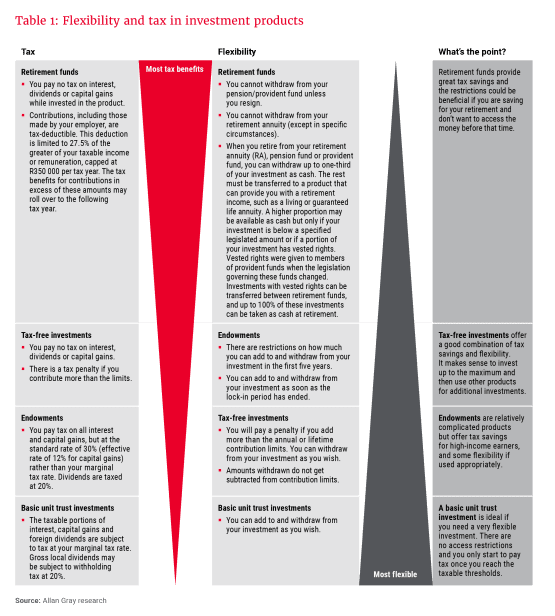The end of February sees the tax year drawing to a close – an opportune time to ensure that your tax affairs are up to date, and to consider taking full advantage of the government’s tax incentives, which encourage us to save.
By making sure your tax affairs are in order, considering the tax implications of your investment decisions, and maximising the tax benefits on offer, you can improve your financial flexibility.
Here are some practical tips:
1. Check your tax status with Sars
From 1 December 2022, administrative penalties are charged if you have one or more outstanding tax returns from the 2007 tax year. Sars may collect these administrative penalties from appointed third parties, such as your employer and investment manager. Check your tax compliance status with Sars as your first step to getting your house in order.
2. Update your tax details with product providers
Supply your tax details, such as your income tax number and country of tax residence, to your investment manager and other product providers – and make sure to update them if anything changes. This enables these parties to apply the correct interest and dividend withholding taxes to your investments and ensures that they submit accurate information to Sars. This, in turn, will ensure that your tax return is prepopulated with the correct data for tax filing. As a taxpayer, you can now view third-party data certificates on your e-filing profile that financial services providers submitted to Sars.
Sars also needs to know whether you are a South African or non-South African tax resident as this impacts your tax liability in South Africa. A registered tax practitioner or financial adviser can guide you through the implications of changes to your tax residency.
3. Monitor your annual capital gains tax exclusion
As an individual taxpayer you are required to submit a tax return for the tax year if your aggregate capital gains or losses exceed R40 000 for the tax year. The purpose of this is to reduce compliance costs and simplify tax administration by keeping small gains and losses out of the tax system.
If you plan to withdraw from a long-term investment, it is useful to be aware of your aggregate capital gain and loss amount for the period, and to remember your reporting obligations.
4. Consider the tax implications of your investment decisions
Tax has a significant impact on your investment return. With so many products to choose from, it is important to understand the tax advantages on offer and to make strategic choices best suited to your needs and circumstances, either on your own, or with the help of a good, independent financial advisor.
Of course, tax efficiency cannot be looked at in isolation – you also need to consider each product’s suitability and flexibility.
Table 1 summarises the role of various investment products, along with their flexibility and tax rules.
5. Maximise tax benefits available through retirement funds and tax-free investments
While making your product choices, it is useful to hone in on the annual tax benefits available to you through your retirement fund and tax-free investment (TFI) account.
How to maximise benefits using retirement funds
As shown in Table 1, a key benefit of investing for retirement using a retirement fund, such as a retirement annuity or an employer’s pension or provident fund, is the generous tax deduction the government provides for contributions, subject to a maximum of 27.5% of the greater of your taxable income or remuneration, with an annual ceiling of R350 000.
If you contribute more than the annual limit, your excess (non-deductible) contributions can benefit you in many ways throughout your lifetime. They can be used to increase the value of any tax-free lump sum you take from a retirement fund before or at retirement, or even on your death, if your beneficiaries choose to take their benefit as cash. They can also be used to reduce the taxable portion of the income you receive from your living annuity.
These excess contributions are carried over to the following tax years and are added to any contributions you make in those tax years, and they continue to be carried over until they are used – so the benefit is never lost.
How to maximise benefits using tax-free investment products
Sars allows individuals to invest a maximum of R36 000 per tax year and R500 000 per lifetime tax-free in a TFI. This is the total amount you can invest across product providers. You will incur a tax penalty of 40% on any amount over these contribution limits, so you need to keep track of how much you’re contributing to your tax-free investments each year. It is also important to note that any amount you withdraw can’t be recontributed, so you should avoid withdrawing from this product unless it is an emergency.
If you are planning to make use of the tax incentives for this tax year by starting a new RA or TFI, or by making an additional contribution to an existing account, make sure your product provider receives supporting documents and payment well in advance of the 28 February 2023 deadline.
Carla Rossouw is head of tax at Allan Gray.

